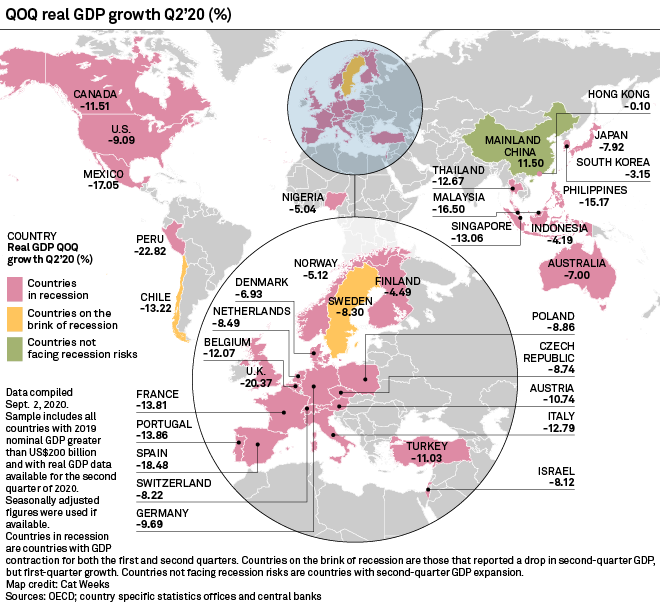No continent could steer clear of the unprecedented coronavirus economic shock, and while a global recovery is underway, there are concerns over how quickly the world economy can return to pre-pandemic levels.
Among the 34 economies with a nominal GDP greater than $200 billion that had reported real GDP data by Sept. 2, 31 were in recession, while two countries — Chile and Sweden — were one quarter away from one. Only China, the world's second-largest economy, saw real GDP expand in the second quarter.
A quick, V-shaped economic recovery is unlikely for most countries because of the depth of the crisis, the World Bank wrote in a Sept. 7 report, saying a rebound in 2021 is expected to match only a fraction of the 2020 slump.
"The COVID-19 pandemic crisis combines the worst characteristics of previous crises," the World Bank said, adding 2020 global GDP is expected to plunge at a pace 3x bigger than that in the 2008-2009 global financial crisis.

To download an Excel version of the entire sample, along with first-quarter and second-quarter GDP figures, please click here.
China, the first country to report a COVID-19 outbreak, returned to economic growth in the second quarter, fueling optimism about a global rebound from the impact of the pandemic.
However, sluggish retail sales remain a "weak point" in an otherwise "solid" Chinese recovery, Jakob Ekholdt Christensen, Danske Bank's chief analyst and head of international macro and emerging market research, wrote in a Sept. 1 note.
The country is unlikely to fully recoup all its lost output before mid-2022 unless a large fiscal stimulus package is rolled out and there is good news on a vaccine, ING Chief International Economist James Knightley said in a Sept. 4 note.
This marked the severest U.K. downturn of the first five post-war recessions, Ruth Lea, economic adviser at Arbuthnot Banking Group, wrote Sept. 1. If the U.K. retains tighter restrictions than major European Union nations, the British economy "will continue to be relatively disadvantaged," Lea said.



